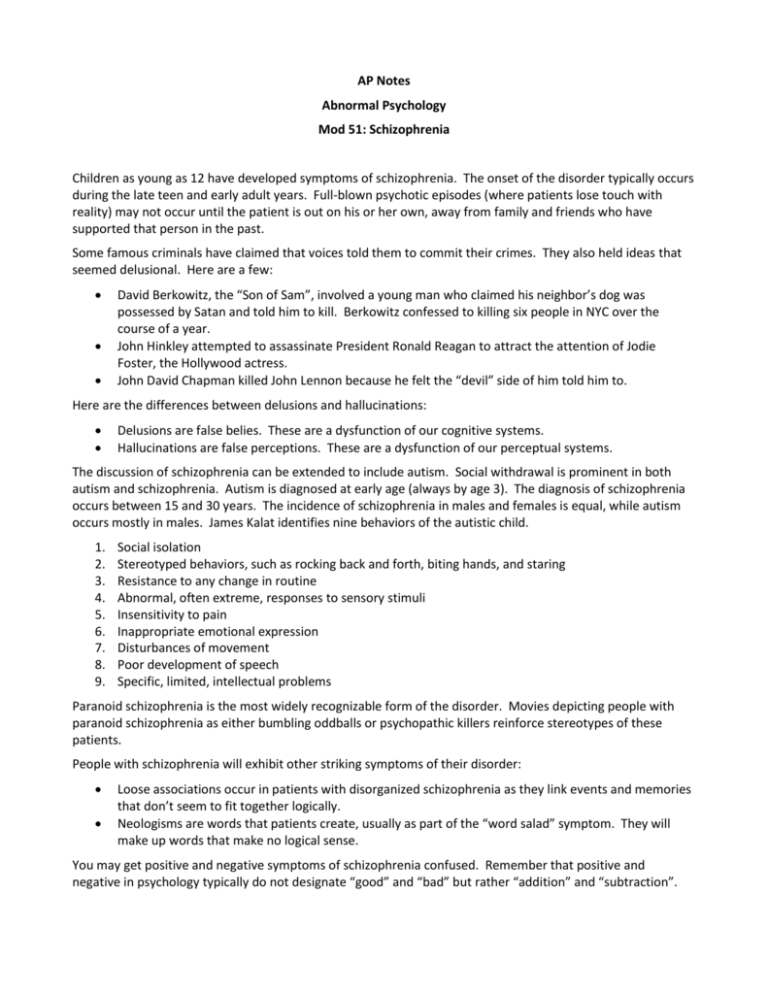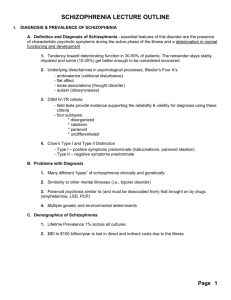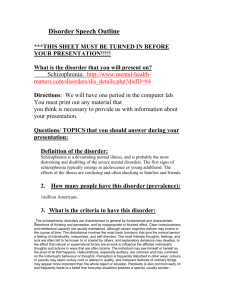AP Notes Mod 51 Schizophrenia
advertisement

AP Notes Abnormal Psychology Mod 51: Schizophrenia Children as young as 12 have developed symptoms of schizophrenia. The onset of the disorder typically occurs during the late teen and early adult years. Full-blown psychotic episodes (where patients lose touch with reality) may not occur until the patient is out on his or her own, away from family and friends who have supported that person in the past. Some famous criminals have claimed that voices told them to commit their crimes. They also held ideas that seemed delusional. Here are a few: David Berkowitz, the “Son of Sam”, involved a young man who claimed his neighbor’s dog was possessed by Satan and told him to kill. Berkowitz confessed to killing six people in NYC over the course of a year. John Hinkley attempted to assassinate President Ronald Reagan to attract the attention of Jodie Foster, the Hollywood actress. John David Chapman killed John Lennon because he felt the “devil” side of him told him to. Here are the differences between delusions and hallucinations: Delusions are false belies. These are a dysfunction of our cognitive systems. Hallucinations are false perceptions. These are a dysfunction of our perceptual systems. The discussion of schizophrenia can be extended to include autism. Social withdrawal is prominent in both autism and schizophrenia. Autism is diagnosed at early age (always by age 3). The diagnosis of schizophrenia occurs between 15 and 30 years. The incidence of schizophrenia in males and females is equal, while autism occurs mostly in males. James Kalat identifies nine behaviors of the autistic child. 1. 2. 3. 4. 5. 6. 7. 8. 9. Social isolation Stereotyped behaviors, such as rocking back and forth, biting hands, and staring Resistance to any change in routine Abnormal, often extreme, responses to sensory stimuli Insensitivity to pain Inappropriate emotional expression Disturbances of movement Poor development of speech Specific, limited, intellectual problems Paranoid schizophrenia is the most widely recognizable form of the disorder. Movies depicting people with paranoid schizophrenia as either bumbling oddballs or psychopathic killers reinforce stereotypes of these patients. People with schizophrenia will exhibit other striking symptoms of their disorder: Loose associations occur in patients with disorganized schizophrenia as they link events and memories that don’t seem to fit together logically. Neologisms are words that patients create, usually as part of the “word salad” symptom. They will make up words that make no logical sense. You may get positive and negative symptoms of schizophrenia confused. Remember that positive and negative in psychology typically do not designate “good” and “bad” but rather “addition” and “subtraction”. Positive symptoms refer to those that are excessive or in addition to normal behaviors. Outlandish behavior such as paranoid delusions, hallucinations, and erratic emotions or behaviors are typical of positive symptoms. Negative symptoms refer to those that are deficient or less than normal behaviors. Flat affect, social withdrawal, and catatonia are common negative symptoms. The discussion of neurotransmitters in Mod 4 can be linked to schizophrenia. Dopamine is similar in chemical makeup to cocaine, which explains why abusers of the drug experience schizophrenia-like symptoms. Also linked to dopamine is Parkinson’s disease, which is thought to result from a lack of dopamine channels in the brain. Patients who take medicine to treat schizophrenia will develop Parkinson’s-like symptoms, such as hand tremors (tardive dyskinesthia). Recent research using brain imagining techniques has shed some light on the biological basis of schizophrenia. People who develop schizophrenia have abnormal brain activity before the onset of symptoms, showing that schizophrenia may be a developmental disorder. MRI studies show that gray matter in the brains of people with schizophrenia is markedly less dense than in people with no schizophrenia. Studies have also shown that people who have auditory hallucinations experience temporal lobe activation, indicating that they really are hearing voices, even though the voices are not present. Again, remember that a genetic predisposition does NOT guarantee that one will get a disorder such as schizophrenia. Environmental and behavioral influences help determine whether someone with a predisposition will develop the disorder.








